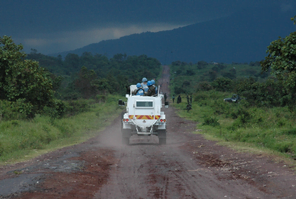The M23 Rebellion in East DRC is over.
What lessons can the international community draw from this apparent success?
1) The UN’s intervention brigade played a critical role in ending this rebellion. Last March, the Security Council approved a 3,000 strong deployment of Blue Helmets who performed tasks not traditionally associated with UN Peacekeeping. This “intervention brigade” undertook offensive missions against the M23 rebels, actively hunting them down. They were aided by intelligence drones and other sophisticated military assets that typically accompany offensive military operations. Tanzania, South Africa and Malawi provided the bulk of the troops, and they helped the Congolese Army deal a decisive military blow to the rebellion.
2) Pressure on Rwanda. The international community has a complicated relationship with Rwanda. There is still lingering guilt for standing idle during the 1994 genocide. Rwanda is also the recipient of a great deal of development assistance, which it has put to good use as it makes impressive economic gains. From a development perspective, it is very much a success story. But Rwanda is also complicit in war crimes in the DRC and supported the M23 rebellion. A UN report drew a straight line from Rwanda’s defense ministry to the M23 rebellion. Last month, the USA finally suspended military assistance to Rwanda, which helped convince Rwanda to finally cease its aid to M23.
Those two factors contributed most directly to the apparent ending of this rebellion. To build on this success, the international community and DRC government are going to have to address some of the underlying conditions that give rise to persistent instability in the region. For now, though, this is a moment to (briefly) celebrate.
What follows is a Twitter Interview I conducted this morning with Laura Seay, a professor at Colby College and one of the country’s foremost experts on the region.
.@texasinafrica How significant a factor was the UN’s “intervention brigade” in ending the M23 rebellion?
— MarkLGoldberg (@MarkLGoldberg) November 5, 2013
.@MarkLGoldberg The FIB was hugely significant in M23’s defeat. The support FIB provided the FARDC made a big difference.
— Laura Seay (@texasinafrica) November 5, 2013
.@MarkLGoldberg FIB also served as positive role models of an effective, professional force. Most FARDC forces have never had such examples.
— Laura Seay (@texasinafrica) November 5, 2013
.@MarkLGoldberg FIB also served as positive role models of an effective, professional force. Most FARDC forces have never had such examples. — Laura Seay (@texasinafrica) November 5, 2013
.@MarkLGoldberg FIB support had a huge effect on FARDC morale. Troops learned they could win in battle. Big deal. — Laura Seay (@texasinafrica) November 5, 2013
.@texasinafrica It seems that the second big factor was Rwanda’s eroding support for M23. What finally caused Kagame to cease his backing?
— MarkLGoldberg (@MarkLGoldberg) November 5, 2013
.@MarkLGoldberg Diplomatic pressure on Kagame to not intervene was strong. He also received assurances that the FDLR will be one of…
— Laura Seay (@texasinafrica) November 5, 2013
.@MarkLGoldberg the FIB’s next primary targets. This addresses a legitimate security concern for Kigali. But the real credit goes to…
— Laura Seay (@texasinafrica) November 5, 2013
.@MarkLGoldberg diplomats who stopped letting Kigali get away with claim that they weren’t involved in DRC, which everyone knew to be true.
— Laura Seay (@texasinafrica) November 5, 2013
.@MarkLGoldberg The UN Group of Experts took a lot of heat for their findings, but those findings convinced the Security Council.
— Laura Seay (@texasinafrica) November 5, 2013
.@MarkLGoldberg And the Security Council’s change of approach has made all the difference.
— Laura Seay (@texasinafrica) November 5, 2013
.@TexasinAfrica what about the US suspension of military assistance? Presumably that helped convinced Kagame to back off.
— MarkLGoldberg (@MarkLGoldberg) November 5, 2013
.@MarkLGoldberg Yes, and other donors cut budget support to Rwanda as well. But it all goes back to the GOE’s findings.
— Laura Seay (@texasinafrica) November 5, 2013
Also, do you think the participation of Russ Feingold has been a boon to prospects for peace? Or was his timing just very good?
— MarkLGoldberg (@MarkLGoldberg) November 5, 2013
.@MarkLGoldberg Hard to say. I think the combination of the new SRSG, Force Commander, & UN & US special envoy’s brought a new energy…
— Laura Seay (@texasinafrica) November 5, 2013
.@MarkLGoldberg to the process. No question that Kobler & dos Santos Cruz are leading more proactively than their predecessors.
— Laura Seay (@texasinafrica) November 5, 2013
.@MarkLGoldberg Adding a higher-level US presence into the mix certainly didn’t hurt.
— Laura Seay (@texasinafrica) November 5, 2013
.@TexasinAfrica last question: what’s next for Eastern DRC? Does intervention brigade turn its sights on FDLR? Is that the next big front?
— MarkLGoldberg (@MarkLGoldberg) November 5, 2013
.@MarkLGoldberg They have to go after the FDLR to keep Kigali happy. Although at the moment, other armed groups are arguably a bigger threat
— Laura Seay (@texasinafrica) November 5, 2013
.@MarkLGoldberg to civilian well-being (eg, Mai Mai Cheka, Raia Mutomboki). But UN has to follow through on promises to Kagame.
— Laura Seay (@texasinafrica) November 5, 2013
.@MarkLGoldberg And not give Kigali another pretext for intervention via proxies.
— Laura Seay (@texasinafrica) November 5, 2013
.@MarkLGoldberg Other big question is peace building efforts. Legitimate Congolese Tutsi grievances won’t disappear with the M23.
— Laura Seay (@texasinafrica) November 5, 2013
.@MarkLGoldberg Other big question is peace building efforts. Legitimate Congolese Tutsi grievances won’t disappear with the M23.
— Laura Seay (@texasinafrica) November 5, 2013
.@MarkLGoldberg Long process of grassroots peace building will take decades. I’m not sure the donors or Kinshasa are committed to it.
— Laura Seay (@texasinafrica) November 5, 2013
.@TexasinAfrica informative and instructive as always. Thank you, Laura! I’m jealous of your students.
— MarkLGoldberg (@MarkLGoldberg) November 5, 2013
.@MarkLGoldberg My pleasure! This was fun.
— Laura Seay (@texasinafrica) November 5, 2013
